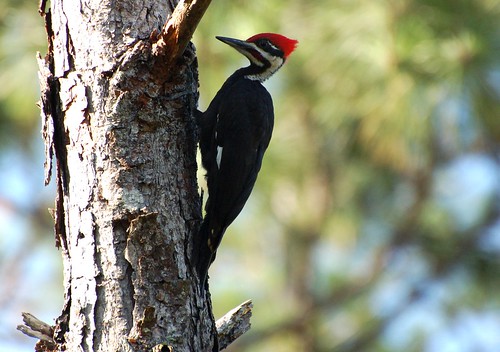 If you live east of the Mississippi river then you have probably had an encounter with a pileated woodpecker whether you realized it or not. The screeching yell from this magnificent bird can not be mistaken because he lets himself be know like no other bird around these parts of the North Carolina mountains, perhaps with the narrow exception of the crow. But when it comes to the pure magnificence of a bird in flight or of a bird defending his own territory, then the crow doesn't come even close to the stature of the pileated woodpecker.
If you live east of the Mississippi river then you have probably had an encounter with a pileated woodpecker whether you realized it or not. The screeching yell from this magnificent bird can not be mistaken because he lets himself be know like no other bird around these parts of the North Carolina mountains, perhaps with the narrow exception of the crow. But when it comes to the pure magnificence of a bird in flight or of a bird defending his own territory, then the crow doesn't come even close to the stature of the pileated woodpecker.As you can tell, I do love this particular bird and they are evidently in abundance in the woods where I live. If you haven't already seen the short video of my close encounter with one such bird about a month ago then you can see it by clicking here.
Just this morning I was preparing for a Boy Scouting class that would arrive in about 15 minutes when all of a sudden you would have thought that a bloody murder fight was taking place on the mountainside about 100 yards away. Of course I knew that it was just another pileated woodpecker marking his territory. I decided to take a very quick ramble to see if I could spy on the bird since this would be an excellent educational opportunity for my natural science classes.
I didn't expect that finding the exact tree of this woodpecker would be as easy as it was, but I actually listened, looked, and walked almost straight to this very tall sourwood tree as seen above. To my amazement there were five nice sized holes all in a row on the south side of the tree with the freshest hole made this morning right on the top.(see third picture above to the right) Fresh bark was scattered all about on the ground and the bird was perched on a limb far away during my inspection.
This sourwood tree was still very alive including healthy bark all the way around it's diameter but the core of the tree did appear to be somewhat hollow. It was also obvious from the healing wounds of the tree around the holes that each succeeding hole moving up the tree was the newest, so this woodpecker just keeps moving up the tree each year. Very interesting I thought.
 I researched the mystery further because I was wondering if the woodpecker was looking for food or if this was a nesting tree. According to my research the pileated woodpecker makes a new nesting hole each year and never uses an older one. Also I learned that the transition between winter and spring is when the male woodpecker is cutting the new nesting hole.
I researched the mystery further because I was wondering if the woodpecker was looking for food or if this was a nesting tree. According to my research the pileated woodpecker makes a new nesting hole each year and never uses an older one. Also I learned that the transition between winter and spring is when the male woodpecker is cutting the new nesting hole.With this information and with the physical evidence I'd have to say that this is a nesting tree. The sourwood tree is also very alive and this bird is cutting through solid wood. Most of the trees used for gathering insects are close to dying (or already dead) and the bark is very brittle and thus a prime habitat for the insects that they need to survive. This strong sourwood tree would be a excellent choice for nesting and I will now keep an eye on it for a few months to be sure.
This nesting tree will make an excellent natural science class hike while also providing an excellent opportunity to research and learn more about this magnificent bird. After some initial research and some good teacher guidance, I'm sure that the kids will also reach the same conclusion that I did. Sometimes my students discover even more theories and possibilities that I do when reading a mystery in the forest so I will be anxious about their conclusions.Since our school incorporates experiential education into the curriculum, this will be another great opportunity. Wonderful stories are everywhere in the woods around us if we can only slow down long enough to discover their mystery.
















No comments:
Post a Comment